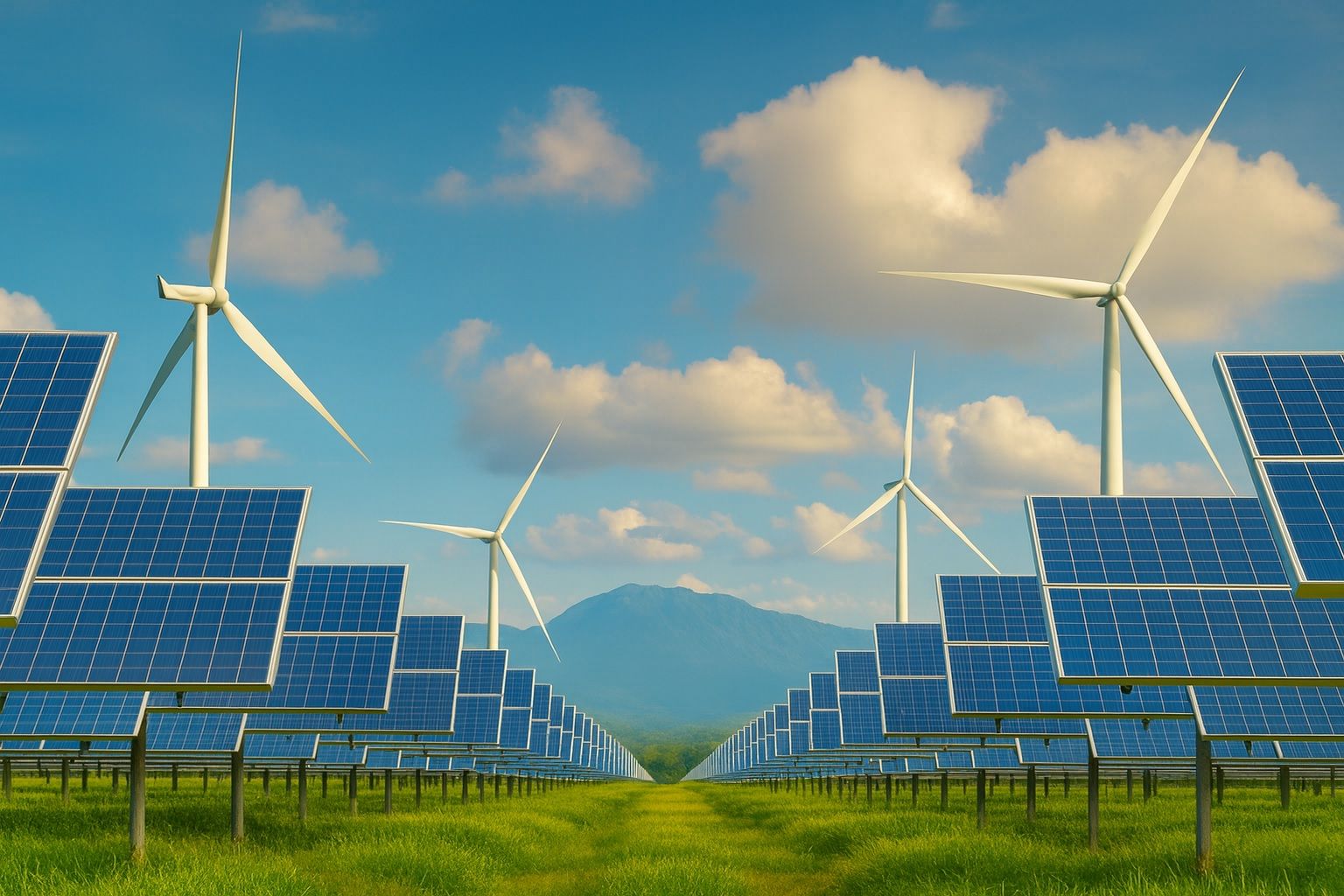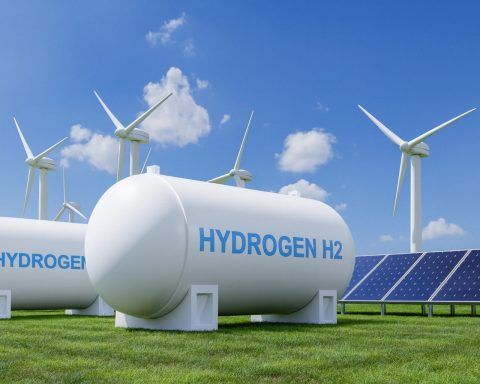BLM on Oct 10 listed the Esmeralda 7 solar project in Nevada as “cancelled” [1] [2]. The massive project (seven contiguous solar farms on ~185 sq mi of public land) would have generated ~6,200 MW – enough for nearly 2 million homes [3] [4]. Interior Secretary Doug Burgum’s Trump administration said developers can now submit individual proposals instead of one programmatic EIS [5] [6]. Conservationists and some locals celebrated the cancellation, while clean‑energy advocates (NRDC, SEIA, EDF) warned it’s a blatant rollback of renewables: NRDC’s Kabir Green calls it “unfettered obstruction” of clean-energy projects [7]. The cancellation comes amid a broader Trump‐era push against renewables: Congress has cut federal tax credits (the “One Big Beautiful Act”) and DOI now requires Burgum to personally sign off on wind/solar projects [8] [9]. As a result, U.S. solar stocks have faltered – NextEra (NEE) sits around ~$80–83 per share in early Oct [10] [11] – and analysts warn of a “boom‐bust” cycle if subsidies vanish [12] [13]. Still, global investment in renewables remains at record highs [14], and experts like Gina McCarthy note companies “remain committed to clean energy investments despite the policy headwinds” [15].
Esmeralda 7 Project Cancelled by Trump Administration
The Bureau of Land Management (BLM) quietly updated its website on Oct. 9 to mark Esmeralda 7 as “cancelled” [16] [17]. Esmeralda 7 was a massive solar + storage complex planned northwest of Las Vegas: seven linked solar farms covering about 119,000 acres (≈185 sq mi) of federal rangeland [18] [19]. Together they would have produced roughly 5.35–6.2 GW (5,350–6,200 MW) of capacity – about three times Hoover Dam’s output – powering nearly 2 million homes [20] [21]. (For scale: the current largest U.S. solar plant is ~1.3 GW [22].) A draft Environmental Impact Statement (EIS) had been completed under the Biden administration, and a final decision was due by April 2025 [23] [24]. Instead, the Trump‐appointed DOI abruptly scrapped the programmatic review. The Interior Department now says developers may “submit individual project proposals to the BLM to more effectively analyze potential impacts” [25] [26] – effectively restarting the process project by project rather than as one big farm.
Official Rationale and Process Changes
Administration officials have defended the move as procedural. In a statement Interior claimed it and the developers “agreed to change their approach” [27] [28]. But observers see it as a policy reversal. Since taking office, Secretary Burgum has branded solar/wind as “intermittent” and unreliable [29], and instituted sweeping new requirements: every utility-scale solar or wind permit now needs his personal sign-off, and projects must meet stricter “capacity density” rules [30] [31]. In July, Trump signed the “One Big Beautiful Bill Act,” moving up the phase-out of clean-energy tax credits by years [32]. Federal agencies have also begun rescinding clean-energy grants (e.g. $7 billion for low-income solar) and canceling approved projects like Idaho’s 1 GW Lava Ridge wind farm [33] [34]. A leaked memo shows DOE plans to claw back over $4 billion in awards [35]. In short, federal policy now overtly favors fossil fuels: the Trump administration has opened new coal leases and “white-glove” fast-tracked oil/gas projects, while placing solar and wind under unprecedented review [36] [37].
Industry and Expert Reactions
Renewable energy leaders blasted the cancellation as politically driven. Kabir Green (NRDC) said the approach isn’t about oversight but “unfettered obstruction” of projects “that create jobs, cut pollution, lower costs” [38]. Solar Energy Industries Association (SEIA) VP Ben Norris lamented that the move “will restrict America’s ability to produce homegrown clean energy” and warned the U.S. “needs more power on the grid, fast… we need the administration to get serious about truly achieving American energy dominance” [39] [40]. Environmental Defense Fund’s Ted Kelly echoed this: canceling Esmeralda 7 “won’t lower electricity bills… restricting the supply of cheap electricity only makes the problem worse” [41]. EDF notes clean energy is now the cheapest way to add power as demand and costs surge [42], and that rolling back renewables while subsidizing coal will only raise prices and emissions [43]. The E&E News outlet quoted GWU energy expert Scott Sklar: Trump’s team has erected a “multitude of regulatory barriers and delays” – its clear aim is to “stop these projects, period” [44]. Columbia law professor Michael Gerrard similarly warned that Esmeralda 7 “may not be the last solar project on federal land to cancel” under the current administration [45].
In Congress and state capitals, supporters of renewables are bracing for fallout. The pushback on solar is part of a trend: Reuters notes Trump’s “renewables attack” on issues from offshore wind to tax credits [46] [47]. At least one GOP governor – Oregon’s Tina Kotek – has already begun countermeasures, expediting state permits to keep projects alive before federal credit deadlines [48]. Industry analysts fear a “boom‐bust” scenario: TS2 reports that clean-energy stocks plunged in mid-2025 as Congress stripped incentives. “Shares of major solar companies plunged… NextEra Energy… now trades around $80 per share (down from over $90 last year)” [49]. Morgan Stanley predicts a steep downturn in new projects without subsidies [50], and the Solar Industries Association warned the rollback “effectively put the brakes on” America’s clean energy boom [51]. In short, investors and developers face heavy uncertainty – TS2 notes NextEra’s stock hit multi-year lows over summer, about 15% below its level a year ago [52].
Local Perspective: “Vegas-Sized” Project Abandoned
Many rural Nevadans were divided on Esmeralda 7. Local opposition – citing its vast scale through sensitive desert habitat – had been strong from the start. Shaaron Netherton of Friends of Nevada Wilderness cheered the cancellation: “Friends of Nevada Wilderness is thrilled that this poorly sited project is dead,” she said, noting the project threatened pristine wilderness and native bighorn sheep [53] [54]. Former Esmeralda County Commissioner Nancy Boland – who had worried the arrays would “really be noticeable” – also expressed relief, saying she was “very happy” that the project died [55]. Basin and Range Watch co-founder Kevin Emmerich agreed: “A lot of these projects are politically not favored by Trump,” he observed [56]. On the other hand, conservation groups in other western states lament that ecologically sensitive concerns are being used as a pretext. Democrats and some Nevada lawmakers – who see renewable projects as job drivers – have not yet issued public statements, but the action has sparked a broader debate on state land use and energy strategy.
National Policy Context: Renewables Rollback
Esmeralda 7’s cancellation is the latest in a systematic dismantling of federal clean energy support. In January 2025, Trump’s DOI paused new wind and solar leasing on public lands [57]. On July 4, Congress and the President enacted the One Big Beautiful Bill Act, ending wind/solar tax credits years earlier than planned [58]. DOI then imposed “elevated review” for solar and wind: almost every decision must now be signed off by Secretary Burgum [59] [60]. Other agencies joined in: EPA pulled $7B in “Solar for All” grants for low-income communities [61], and Agriculture vowed to phase out renewable energy support on farmland [62]. The Commerce Dept. launched a national-security probe into imported wind turbine components [63], effectively stalling offshore wind (e.g. Ørsted’s Maryland project was ordered stopped) [64].
These moves come as demand for power is surging. The U.S. Energy Information Administration (EIA) now projects record electricity use in 2025–2026 [65] [66]. Under normal trends (with an IRA-like policy baseline), EIA sees renewables’ share climbing from ~23% in 2024 to ~24% in 2025 and ~26% by 2026 [67]. But with federal projects stalled, many clean-energy planners fear those gains could slow or stall. Bloomberg Green analyst Paul Gerke noted that despite the political rhetoric, “when the rubber meets the road, electric utilities are still turning to carbon-free sources” [68] – since renewables are now the cheapest and fastest option. Still, Trump’s policies introduce uncertainty: TS2’s market briefing warns that policy reversals could create a sharp downturn in capacity additions through the late 2020s [69] [70].
Market Impact: Stocks and Forecasts
The policy U-turn has already been priced into financial markets. As noted above, leading renewable stocks slid over 2025. For example, NextEra Energy (NYSE: NEE) – the nation’s largest clean utility – traded around $78–$83 per share in early October (about 15% below its level a year prior) [71] [72]. First Solar (NASDAQ: FSLR) closed Oct. 10 at roughly $226 [73] [74], after starting 2025 above $300 – reflecting similar investor nerves. Solar installer stocks (Sunrun, Enphase) and wind companies have likewise underperformed the broader market on these headwinds.
Analysts now debate the outlook. Without federal tax credits, many projects will race to be “shovel-ready” by mid-2026 to avoid losing incentives. TS2 notes some hope that underlying economics can still carry the sector: “many big companies remain committed to clean energy investments despite the policy headwinds,” observed former EPA chief Gina McCarthy [75]. Global trends support that optimism: worldwide clean tech investment is booming (≈$2.2 trillion in 2025 [76]), and falling costs mean solar and wind projects are often cheaper than new fossil plants. Forecasts suggest U.S. renewables growth will resume if federal policy normalizes: for example, the IEA expects renewables to surpass coal as the largest power source globally by 2025 [77]. On the other hand, conservative estimates by some Wall Street analysts foresee a temporary drop in U.S. capacity additions in 2026–27 without credits, possibly requiring states to pick up the slack with local incentives.
Outlook: A Turning Point for U.S. Energy
The Esmeralda 7 cancellation crystallizes the Trump administration’s approach to energy: prioritizing fossil fuels and constraining federal support for big solar and wind. It raises near-term questions about grid reliability and power costs in fast-growing states like Nevada. Solar advocates warn that delaying large projects will slow emissions reductions when every megawatt counts. As SEIA’s Norris put it, the industry remains “deeply concerned” that clean projects are being stalled while “cheaper renewables and storage get freezes, delays and cancellations” [78]. Policymakers will now weigh whether to press ahead at the state level or adjust market incentives. For investors and consumers, the next few months will reveal how resilient U.S. renewable energy will be in the face of these headwinds. Investor takeaway: Watch stocks and project bids closely – if mid-2026 deadlines loom without policy relief, expect market volatility. Policy takeaway: Renewables still offer low-cost growth, but they may need new support or faster permitting at the local level until federal policies become more stable.
Sources: Major news outlets and industry reports from Oct. 2025 [79] [80] [81] [82], expert statements (EDF, NRDC, SEIA) [83] [84] [85], plus market data [86] [87] and analyses [88] [89] [90]. All linked sources available above.
References
1. www.energyconnects.com, 2. www.theguardian.com, 3. pv-magazine-usa.com, 4. www.theguardian.com, 5. www.energyconnects.com, 6. electrek.co, 7. pv-magazine-usa.com, 8. www.energyconnects.com, 9. www.reuters.com, 10. ts2.tech, 11. www.investing.com, 12. ts2.tech, 13. ts2.tech, 14. ts2.tech, 15. ts2.tech, 16. www.energyconnects.com, 17. www.theguardian.com, 18. thenevadaindependent.com, 19. www.theguardian.com, 20. pv-magazine-usa.com, 21. electrek.co, 22. pv-magazine-usa.com, 23. thenevadaindependent.com, 24. electrek.co, 25. www.energyconnects.com, 26. electrek.co, 27. www.eenews.net, 28. electrek.co, 29. www.eenews.net, 30. www.energyconnects.com, 31. www.eenews.net, 32. www.reuters.com, 33. www.reuters.com, 34. www.reuters.com, 35. insideclimatenews.org, 36. www.edf.org, 37. www.edf.org, 38. pv-magazine-usa.com, 39. thenevadaindependent.com, 40. www.eenews.net, 41. www.edf.org, 42. www.edf.org, 43. www.edf.org, 44. www.eenews.net, 45. www.eenews.net, 46. news.bloomberglaw.com, 47. www.reuters.com, 48. ts2.tech, 49. ts2.tech, 50. ts2.tech, 51. ts2.tech, 52. ts2.tech, 53. www.eenews.net, 54. thenevadaindependent.com, 55. thenevadaindependent.com, 56. thenevadaindependent.com, 57. www.reuters.com, 58. www.reuters.com, 59. www.reuters.com, 60. www.eenews.net, 61. www.reuters.com, 62. www.reuters.com, 63. www.reuters.com, 64. www.reuters.com, 65. ts2.tech, 66. www.reuters.com, 67. www.reuters.com, 68. ts2.tech, 69. ts2.tech, 70. ts2.tech, 71. ts2.tech, 72. www.investing.com, 73. investor.firstsolar.com, 74. electrek.co, 75. ts2.tech, 76. ts2.tech, 77. ts2.tech, 78. www.edf.org, 79. www.energyconnects.com, 80. pv-magazine-usa.com, 81. www.theguardian.com, 82. www.eenews.net, 83. pv-magazine-usa.com, 84. www.eenews.net, 85. www.edf.org, 86. ts2.tech, 87. www.investing.com, 88. ts2.tech, 89. ts2.tech, 90. www.reuters.com










